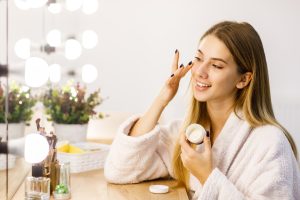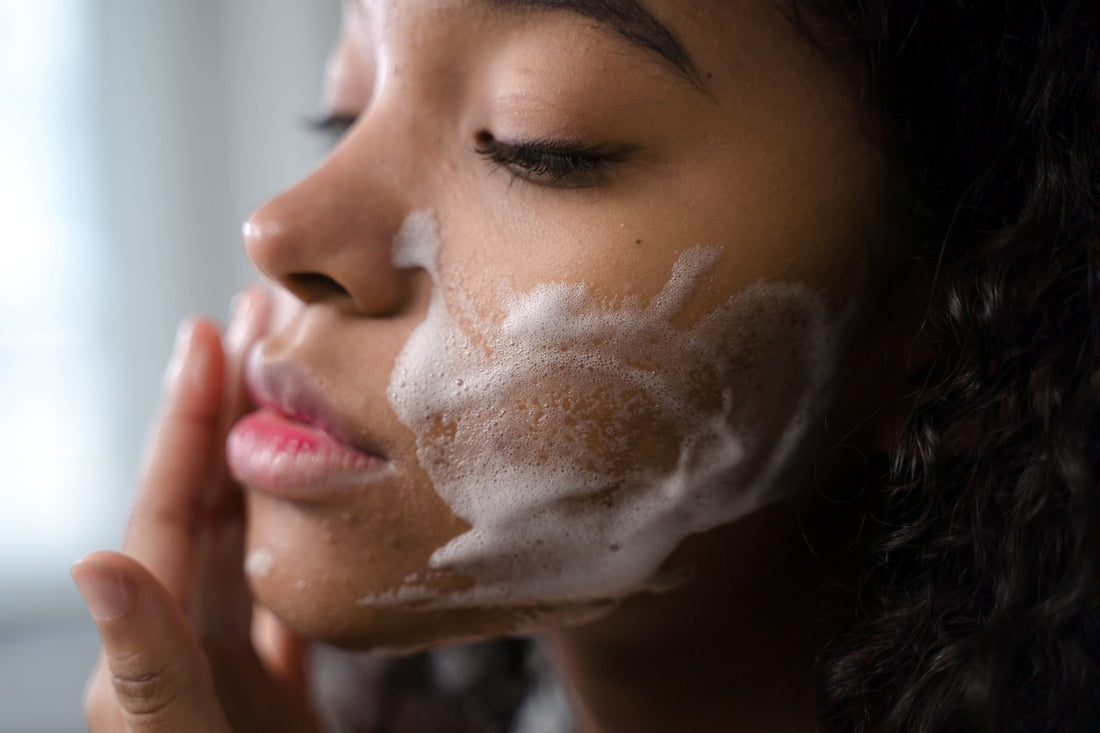Table of Contents
Basic Skin Care Routine: The Only Guide You’ll Ever Need
Let’s face it—navigating the world of skincare can feel overwhelming. With thousands of products, trends, and steps flooding your feed, it’s easy to think you need a 10-step routine to achieve healthy skin. The truth? A basic skin care routine is all you need to keep your skin clean, protected, and glowing.
In this guide, we’ll break down the steps you need, what products to use, and how to build a routine that works for any skin type. Whether you’re just starting or simplifying your overloaded regimen, this is the guide that helps you build habits your skin will love.

Why a Basic Skin Care Routine Matters
Your fundamental skin care regimen is the cornerstone for healthy, beautiful skin—more important than any fashionable treatment or premium product. To properly care for your skin, you do not need to follow a difficult 10-step method. Instead, consistency and simplicity make all the difference.
Your skin is not just the biggest organ in your body; it is also your first line of protection against environmental stresses such as UV radiation, pollution, and germs. When you follow a regular skincare regimen, you’re doing more than simply washing your face; you’re building a strong, durable barrier to protect your entire body.
Here’s why a simple and consistent routine truly matters:
1. It Removes Dirt, Oil, and Pollution Buildup for a basic skin care routine
Your skin produces natural oil and is exposed to environmental contaminants on a daily basis. These pollutants accumulate and clog your pores if you don’t regularly clean them, which causes irritation, blackheads, and acne. All of that can be avoided with a simple cleansing procedure.
2. It Maintains the Hydration and Balance of Your Skin
By preserving your skin’s natural lipid barrier, proper moisturization helps stop dryness and water loss. Additionally, this barrier protects against allergies and dangerous germs. Hydration is essential to maintaining smooth, firm, and resilient skin, regardless of your skin type—dry, oily, or sensitive.
3. It Minimizes and Avoids Breakouts
Breakouts are the most prevalent skin problem, and they can be avoided by cleansing, moisturizing, and using non-comedogenic (pore-clogging) products. Maintaining a regular routine helps you determine what causes acne or pimples so you can treat them properly and prevent the condition from getting worse.
4. It Postpones Early Aging
Sun exposure is one of the main factors contributing to premature aging. You may drastically lower your risk of developing wrinkles, age spots, fine lines, and sagging skin by using sunscreen every day. There will be more long-term advantages the earlier you begin.
5. It Aids in Skin Understanding
Regularly adhering to a schedule makes you more conscious of skin changes. You’ll be able to take action before irritation, dryness, or breakouts worsen since you’ll notice them earlier. Consider your skincare routine as a way to check in with your skin every day.
6. It Encourages Self-Belief in Your Skin
Let’s face it, you feel better about yourself when your skin looks beautiful. Maintaining a regular regimen can improve your attitude and self-esteem in addition as the condition of your skin. Comfort and self-care can come from following a schedule that works.
7. Over Time, It Saves You Money
Consistently using the appropriate goods will save you money on trendy, ineffective things or emergency treatments. You can avoid making mistakes with items that could irritate or damage your skin by investing in a few high-quality basics.
- It Creates Healthful Routines
A skincare routine creates a healthy lifestyle habit, just like brushing your teeth or drinking adequate water. It teaches you the importance of taking tiny, everyday steps that add up to big things over time. Additionally, it becomes second nature once it’s ingrained in your habit and no longer feels like a bother.
Consistency is more important for good skincare than quantity.
Many people make the mistake of constantly switching items or following trends. But stability is good for your skin. When you figure out what works and stick with it, it responds the best.
Determine Your Skin Type First
Determine your skin type before creating your routine. This will help you choose the right products and prevent needless irritation.
This is a brief guide:
Skin that is greasy: Shiny, particularly in the T-zone (chin, nose, and forehead)
- Dry skin can feel flaky, tight, or scratchy.
- Skin type combination: dry in some places, oily in others
- Sensitive skin: May hurt or turn red; reacts readily to new products.
- Normal skin: uniform tone and texture, few problems
Cleanse your face and wait an hour without applying anything to find out your skin type. Note the sensation of your skin:
Flaky and tight skin means dry skin.
Oily skin is slick or shiny all over.
Shiny just on the nose, chin, and forehead = Combination skin.
Normal skin means no serious problems
The Three-Step Foundational Skincare Protocol
Three fundamental steps make up a healthy skincare routine:
- Tidy Up: Begin with a New Canvas
Cleaning purges your skin of pollutants, oil, perspiration, and makeup. It prepares your skin for the following procedures and stops breakouts.
Cleaning advice:
- Every day, wash your face in the morning and at night.
- Use warm water instead of hot.
- Select a mild, scent-free cleanser that is appropriate for your skin type.
Keep your natural oils intact by avoiding harsh soaps and excessively foamy cleansers. Try using a cleansing oil or micellar water first, then a water-based cleanser at night if you wear sunscreen or makeup.
- Apply moisturizer to your skin to strengthen and hydrate it.
To remain balanced, smooth, and shielded from environmental assaults, your skin requires moisture. A good moisturizer is beneficial for even oily skin.
Things to search for:
- Rich cream containing ceramides or shea butter for dry skin
- Lightweight lotion or gel for oily skin
- Formula for sensitive skin that is non-irritating and fragrance-free
Ingredients that are great for hydration:
- The skin is drawn to moisture by hyaluronic acid.
- Glycerin keeps you hydrated.
- Ceramides strengthen and restore the epidermal barrier.
- Skin tone is balanced and soothed with niacinamide.
- To seal in moisture, use a moisturizer when your skin is still a little wet.
- Protect: Always Wear Sunscreen
Although it’s the most crucial stage, most people overlook it. Skin cancer, pigmentation, and premature aging are all brought on by UV radiation.Make use of a broad-spectrum sunscreen with at least SPF 30.
How to apply:
- Applying should be done every morning, even on overcast days.
- Apply around the size of a cent to your face.
- When outside, reapply every two to three hours.
Chemical sunscreens provide lighter alternatives, but mineral sunscreens (titanium dioxide or zinc oxide) are excellent for sensitive skin
Optional Extra Care Add-Ons
After you’ve established your fundamental routine, you can add a few steps to address certain issues. However, don’t overdo it; your skin doesn’t require everything at once.
- Toner
Aids in skin pH balancing and prepares the skin for improved product absorption.
Ideal for skin that is greasy or prone to acne
2. Serum
For particular issues, serum provides a concentrated dosage of active substances.
Common components in serums:
Vitamin C: Antioxidant protection and brightening
- Niacinamide: Reduction of redness and regulation of oil
- Salicylic acid: a remedy for acne
- Retinol: Support for acne and anti-aging (take only at night)
Use serums two to three times a week at first, then progressively more frequently.
- Exfoliator
- Exfoliators clear clogged pores and remove dead skin cells.
- Use once or twice a week, but not every day.
- Instead of using abrasive scrubbing, use chemical exfoliants (AHA/BHA).
- While BHAs like salicylic acid target acne and congested pores, AHAs like glycolic acid aid with dullness.
- Masks for the face
Used once or twice a week to help skin detoxify, reduce inflammation, or increase hydration.
- Clay masks for skin that is oily or prone to acne
- Sheet masks for glowing and hydrating
- Masks for deeper moisture that last all night
An example of a nightly and morning routine cleaner
- (Optional) toner
- (Optional) serum
- A moisturizer
- Sunblock
What’s the Time Frame for Results?
Real, long-term benefits require time, even though some products give you a temporary glow.
- One week: Skin feels more moisturized and cleaner.
- 2–4 weeks: Calms out, tone stabilizes.
- After 6–8 weeks, the active substances (retinol, for example) start to show results.
- 3–6 months: Notable alterations in wrinkles, pigmentation, and scars
Take pictures every two weeks to track your development and identify minor advancements.
Skincare Advice for Teens (ages 13 to 19) and Other Age Groups
Use only the essentials: sunscreen, moisturizer, and cleanser.
- Apply benzoyl peroxide or salicylic acid spot treatments.
- Refrain from utilizing too many activities simultaneously.
20s-30s
- Begin utilizing antioxidants such as vitamin C.
- Use light exfoliants weekly.
- Consider taking retinoids to postpone indications of aging.
40s and beyond.
- Use thicker and more nourishing creams.
- Incorporate peptides and ceramides.
- Don’t forget about your neck, chest, and hands!
Common Skincare Myths To Avoid
- Myth: Oily skin does not require moisturizer.
- Truth: It totally does—just select oil-free formulations.
- Myth: Scrubbing harder leads to better outcomes.
- Truth: Over-exfoliation weakens your skin’s barrier.
- Myth: Natural is always safe.
- Truth: Natural products may still cause inflammation.
- Myth: You do not need sunscreen inside.
- Truth: UVA rays may permeate windows and harm your skin
How To Patch Test New Products
Always do a patch test to avoid any undesirable reactions:
- Apply a tiny bit behind the ear or inside your arm.
- Wait 24 to 48 hours.
- Check for redness, itching, or irritation.
This is especially critical for serums, exfoliants, and active ingredients like as retinol or AHAs.
Skincare is Self-Care.
Skincare is more than simply washing and moisturizing; it’s a little kind of self-love. Your regimen may be a relaxing habit that benefits not only your skin but also your psyche.
Light a light, play some music, and enjoy the process. Take time for yourself.
Skincare is self-care. You deserve it.
Checklist for basic skin care routine: – Use a gentle, non-stripping cleanser.
- Moisturizer – Hydrating and appropriate for your skin type.
- Sunscreen: Broad-spectrum SPF 30+
- (Optional) Serum, toner, or mask to address issues
- Exfoliate once or twice every week.




